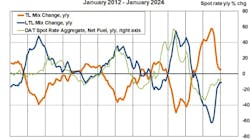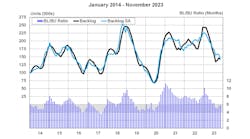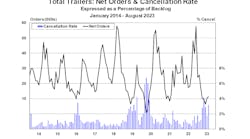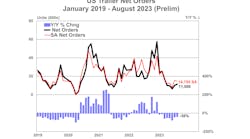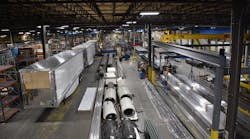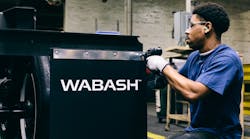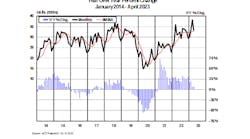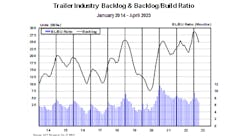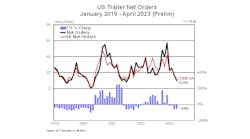Managing director of Aegis Capital says FTR forecasts were too high for trailers and Class 8 trucks
Jeff Kauffman, managing director of Aegis Capital Corporations, said FTR CEO Eric Starks asked him to “throw some rocks at the forecast” in his presentation, “View From the Financial World: An Alternative Heavy Duty Equipment Forecast.”
And so he did.
These weren’t rocks that shattered windows, but they did provide a few noticeable cracks.
For example, Kauffman thinks Don Ake, FTR’s CV equipment expert, overestimated the trailer market with his forecast for 285,300 trailers in 2018, a 1.4% gain over 2017, followed by 280,000 in 2019, 275,000 in 2020, and 278,000 in 2021.
Kauffman’s forecast for 2018 is 265,000, and his estimates for 2019 and 2020 are 5000 below Ake’s.
“I think there are still 150,000 trailers that have yet to be replaced from that late 1990s cycle, so I’m factoring 20,000 to 25,000 trailers a year for replacement versus Don’s 15,000,” Kauffman said. “I agree with Don that there is a bit of a pre-buy going on—less than 10,000 this year, and that’s going to fade next year. I get a 200,000 base, 20,000 for GDP. If the GDP ends up being 3.5% to 4%, add another 20,000 to 25,000. I have 25,000 for replacement, 10,000 potentially for a pre-buy.
“I get a trailer forecast of 265,000, below Don’s 285,000. I’m not going to say Don can’t be right, but my view is that we had energy markets coming back this year. We had construction markets coming back this year. That effect is going to fade. I’m about 5000 below him in 2019 and 2020. I think what everyone got wrong is this is the first cycle we had in 20 years that wasn’t driven by a pre-buy in Class 8. This cycle, we actually bought based on profitability and cash flow. And I think that’s why this cycle is not a mountain peak. It’s kind of a flat top. We’re going to be in 260,000 to 270,000 for the next few years.”
He also forecasts a Class 8 market of 260,000 trucks in 2018, as opposed to Eric Starks’ 300,000. Kauffman’s breakdown is a base of 225,000 in replacements a year (observed at 1.75% GDP), 25,000 for GDP and 10,000 for carrier profit margin in the second half of next year.
“Most carriers had their fleets where they wanted them to be before this year, so there’s no catchup on the heavy-duty side,” Kauffman said. “We’re not looking at an aged heavy-duty truck fleet. I get 260,000 trucks, not 300,000. I don’t have a big replacement cycle in here and can’t get to that big of a number. On top of that, I’ve got ELDs coming and people are going to be hurting for drivers. These rates are going to go up and we’ll have to go out and hire drivers before we can hire trucks.
“I’m not so sure were going to get to 300,000. Now maybe 300,000 in 2019 after a year of having to figure out ELDs and a year of carriers having better margins to put new drivers into driver trade schools. Then I could see that happening.”
Kauffman thinks the last-mile delivery effect will cause some freight that used to go Class 6-7 to start going to Class 4-5. He projects 132,000, 135,000, and 140,000 for Class 6-7 in the next three years, and 79,000, 80,000 and 85,000 for Class 4-5, for totals of 211,000, 215,000, and 225,000.
“This is a consistent market, but diverse and tricky,” he said. “Medium is one of those markets that doesn’t exactly move 20% in a year and smack you in the face. It’s pretty stable right now. With corporate profits heading higher, real estate values heading higher, we’re pretty good there.”
The big unknown is the effect of two massive hurricanes that devastated two large Gulf Coast markets: Harvey in Texas and Irma in Florida.
“Harvey could be the game changer in the forecast we’re not thinking about,” he said. “It did damage to a larger population area than Katrina and Rita and will have a larger economic impact to housing, autos, and industrial capacity. It should create a prolonged period of restoration and construction. There were half a million cars destroyed because of Harvey. What if we have to rebuild houses? This could be a big impact for freight. It will result in incremental freight flows. The result is difficult to determine right now. It could result in incremental flows north from Mexico.”
He said FTR’s forecast of increases of 14% in trailers this year and 8% for next year, and 7% for heavy-duty trucks is “a colossal change in thinking, given what I’ve known about FTR over the years. It’s probably the first time that no one has the recession forecast.”
Then he threw some more rocks:
• Can truckers afford to buy new equipment?
“Who’s going to pay for this? At 4.5% margins, these are not the levels by which big equipment purchase cycles happen. You’ve got to really get up to that 5% to 6% range before the big orders come in. I guess the question I have is that what many people think will happen in 2018 may happen in 2019. We have to see cash flow get better and then CFOs will say, ‘OK, it’s time to buy more trucks.’ A lot of fleets I talked to are talking about extending their equipment years—go from three years to four years, from four years to five years. That’s not telling me there is pent-up demand for equipment right now.”
• ELDs.
“They’re effective December 17 and unlikely to have a significant impact until the spring. We believe there will be a 3% to 4% capacity impact when all is said and done.”
• Tax reform.
“It could be a 2018 item. The impact is uncertain, but it would boost corporate profits.”
• GHG 2.
“It could change purchasing patterns if changed.”
• The Amazon/Uber effect.
“Distribution models are changing. That could change truck types.”
Kauffman started off his presentation by addressing the mindset and sentiment in the economy.
“The market is coming off all-time highs, so people feel pretty good,” he said. “They feel pretty good about what’s going on out there. If you take a look at what’s going on domestically in the US, we’re seeing better productivity from a lot of different areas in the economy. Energy has come back. Machinery has come back. We’re not in an industrial recession anymore. Yeah, we have stagnation politics, but I think tax reform has come out of people’s estimates. Infrastructure spending isn’t really being forecast in there. We do have interest rates rising, but at a very measured pace, and we’re not measured about choking off the financial system.
“I think the biggest thing affecting freight as far as I can tell is it looks like the big inventory overhang is gone. For the last two years, we’ve been talking about the inventory overhang, whether it was retail inventories, coal inventories, or industrial inventories. Well, it seems like we’re starting to get a little inventory rebuild again in the latest GDP data. So from that standpoint, I think we’re pretty good.”
On the international front:
• Uncertainty is moderating.
“The big point is the rest of world is starting to heal. A very good point to make is we actually may have other parts of the world that are growing a little bit faster and better than we are for a change.
“We’re starting to see this change in the trade data. Energy price and currency changes are boosting China, Europe, and Japan. There are various government stimulus programs across Europe, Japan, and China. There is less sovereign risk uncertainty.”
He provided the consensus financial markets view—the best guess of what 30 different people that forecast this on Wall Street are thinking:
• 2017 real GDP around 2.3%, rising to 2.5% in 2018.
“This implies truck freight in the 3% to 4% range.”
• Corporate profits pick up in the second half of this year to about 8%.
“Corporate drives everything—hiring capital spending, equipment sales, credit markets. And that’s healthier, too, which is a big thing, because corporate profits will drive Capex increases in 2018—probably more as we get into 2019, because CFOs generally like to see corporate profits be higher for a year before they OK the increase in spending at fall board meetings.”
